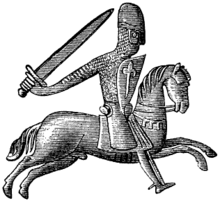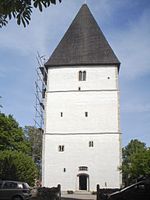Magnus Minneskold
Magnus Minnesköld (also Magnus Minniskiöld; * in the 12th century; † January 31, 1208 in the Battle of Lena ) was a Swedish nobleman and district judge, who became the closer ancestor of the Swedish ruling house of the Folkunger , which a large number of high dignitaries and from 1250 established the kings of Sweden until 1387.
origin
Magnus Minnesköld comes from a family that was referred to as the "Bjälbo family" (Swedish: Bjalboätten) after their ancestral home Bjälbo (today in the municipality of Mjölby in Östergötland ).
The oldest ancestor is Folke the Fat , who lived around 1100 and was such a powerful man that he married a daughter of Canute IV the Holy , King of Denmark (1080-1086) and thus became one of the first magnates of Ingegerd Kingdom of Denmark counted. Folke's origin is not entirely clear. After the Danish historian Saxo Grammaticus (* ca. 1140 † ca. 1220) he was a member of the Swedish Uradels because it him in the early 12th century in his work Gesta Danorum as "Sueticae gentis nobilissimus" the Swedish people (chief ) denotes [1] and writes that he was "in possession of large estates and strong locks in the Göthalanden".
Because of the first name, however, as Brenner mentioned, there are also assumptions that it came from France and could possibly be identical with Foulques de Beaumont , Seigneur de Montevrault , (in France documented until around 1086).
The father of Magnus Minnesköld was the Swedish magnate Bengt Folkasson Snivil , Jarl in Sweden, who was a son of Folke the Fat and Princess Ingegerd of Denmark (a daughter of Knut the Saint ) from the house of Torkel Björnsson , also called Thorgils Sprakalägg .
The name and origin of Magnus Minnesköld's mother are not known.
Life
In the brother's shadow
Magnus Minnesköld's life was shaped by his social background - as a member of one of the most powerful families in Sweden with family ties to the rulers of Denmark and Norway - but also by the fact that he was not the eldest son and therefore not the head of his family was. He was the younger brother of Birger Brosa (around 1161, † January 9, 1202), who was King of Sweden (1167–1196) by Knut Eriksson in 1174 (son of Erik IX. Jedvardsson "the Holy", King of Sweden (1156–1196) 1159)) to the Jarl (Duke) in Sweden - "Jarl of the Swedes and Gauts" - was appointed. Birger Brosa was able to hold this position under Knut's successor Sverker II (1196–1208) for almost thirty years until his own death in 1202.
Magnus was therefore in the shadow of his powerful brother, who blocked his prospect of the highest office under the king - that of Jarl. Although further details are not known, there is probably no doubt that he - together with his older and younger brother, Karl, called "the dove", († August 8, 1220), who in turn was Jarl from 1216 to 1220 was in Sweden, played an important role in Sweden and at the royal court.
Role in the battle for the crown
It is clear that he in the struggle between Sverker II. Karlsson from the House of Sverker and Erik X. Knutsson from the House of Eric was actively involved at the Swedish crown.
This battle was fought in three battles:
In the battle of Älgarås (today a place in the Swedish municipality of Töreboda in Västergötland ) in November 1205 - in which Sverker II defeated the pretender Erik Knutsson. In the Battle of Lena (today Kungslena in Västergötland) on January 31, 1208 - in which Erik Knutsson with a Swedish-Norwegian army defeated King Sverker II and his predominantly Danish army, drove him from the throne and replaced himself as Erik X made King of Sweden (1208–1216). As well as in the Battle of Gestilren (perhaps near Enköping in Uppland ) on July 17, 1210 - in which the expelled King Sverker II tried with a Danish army to regain his throne, but was defeated and fell in battle.
Magnus Minneskjöld probably took part in the fighting as the general of King Sverker II, as he had only achieved the Swedish crown in 1196 thanks to the support of his brother, Birger Brosa - then Jarl of Sweden.
Death in battle
This power struggle was ultimately to seal the end of Magnus Minnesköld. He fell as part of these internal armed conflicts - probably in the Battle of Lena on January 31, 1208 . Possibly, however, not until the Battle of Gestilren on July 17, 1210 .
Marriage and offspring
Magnus Minnesköld was married twice.
There is no further information about his first wife.
Magnus married around 1195 - as his second wife - Ingrid Ylva Sunesdotter (* approx. 1180, † approx. 1250–1255) a daughter of Sune Sik, (* c. 1154), who - one follows the Swedish reformer and historian Olaus Petri (* 1493, † 1552) - probably a younger son of King Sverker I of Sweden (1130–1156). Ingrid Ylva is remembered by the tower of the parish church in Bjälbo named after her, from which she attended mass and in which she is said to have found refuge in case of danger.
Children:
From 1st marriage:
- Eskil Magnusson (Bjälboätten) († approx. 1227), Lagman (law spokesman / district judge) in Västergötland ⚭ 1217 Kristina Nilsdotter († 1254), daughter of Nils Blaka and Katharina Eriksdotter of Sweden († 1209). Kristina was married to the Norwegian Jarl Hakon "galinn" (the madman) and a granddaughter of Erik IX. Jedvardsson "the saint", King of Sweden (1156–1160) and patron saint of Sweden.
- Ne Magnusdotter (Bjälboätten) ⚭ Sigtrygg Bengtsson (Boberg) († n. 1219)
- Karl Magnusson (Bjälboätten) († August 8, 1220 in the Battle of Lihula in Estonia ), Bishop of Linköping (1216–1220) and Swedish Chancellor.
From 2nd marriage:
- Bengt Magnusson (Bjälboätten) († January 4, 1237), succeeded his brother Karl Magnusson as Bishop of Linköping (1220–1236)
- Birger Magnusson (Bjälboätten), called Birger Jarl (* approx. 1210, † October 21, 1266 ), 1248 imperial administrator of the Kingdom of Sweden, founder of the city of Stockholm ⚭ 1.) Ingeborg Eriksdotter , Princess of Sweden († June 17, 1245), daughter from King Erik X. Knutsson of Sweden (1208-1216) ⚭ 2.) 1261 Mechthild von Holstein (* 1220/25, † 1288 in Kiel ); Widow of King Abel of Denmark (1250–1252), daughter of Count Adolf IV. Von Schauenburg and Holstein .
- His son Waldemar I. Birgersson (* 1243 , † December 26, 1302 ) was the successor of his maternal uncle, Erik XI. Eriksson , called "the Lispelnde and Lame" King of Sweden (1222–1250), was the first of the Bjälboätten - better known as Folkunger - King of Sweden (1250–1275).
Individual evidence
- ^ S. Otto Brenner: Descendants of Gorms the Old King of Denmark 936 I. - XVI. Generation ; Dansk Historisk Haanbogsvorlag DK- 2800 Lyngby 2nd edition (Reprint 1978), No. 137, ISBN 87-85207-20-9 .
- ↑ S. Otto Brenner: op. Cit. No. 71
- ↑ S. Otto Brenner: op. Cit. No. 49
- ↑ Saxo Grammaticus : “ Gesta Danorum ” (16-volume history of Denmark in Latin) Book XI, Chapter 14
- ↑ S. Otto Brenner: op. Cit. Commentary on No. 71
- ↑ S. Otto Brenner: op. Cit. No. 93
- ↑ S. Otto Brenner op. Cit. No. 136
- ↑ Olaus Petri: "En svensk krönika" (A Swedish Chronicle)
- ↑ Detlev Schwennike: European family tables, Verlag JA Stargardt, Marburg, 1980 New Series, Volume II, Plate 116
literature
- Koht, Halfdan (1929) The Scandinavian Kingdoms until the end of the thirteenth century (Cambridge University Press)
See also
Web links
| personal data | |
|---|---|
| SURNAME | Magnus Minneskold |
| ALTERNATIVE NAMES | Magnus Minniskiöld |
| BRIEF DESCRIPTION | Swedish nobleman |
| DATE OF BIRTH | 12th Century |
| DATE OF DEATH | January 31, 1208 |
| Place of death | Kungslena |





